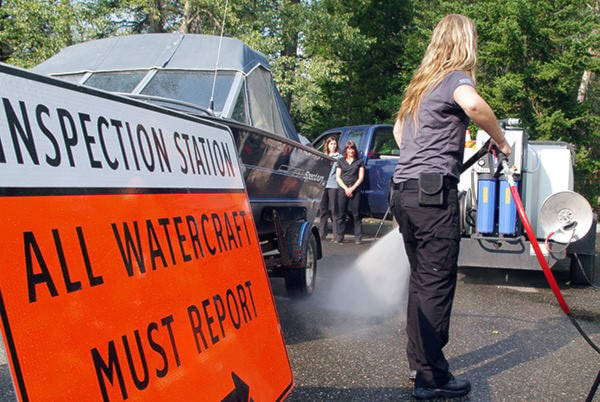Spring in the Shuswap has many thinking about lake cruises, paddling, fishing and tow sports.
But May is also Invasive Species Action Month and here in the Shuswap, that means turning up the heat on aquatic invasive species prevention.
The increased movement of boats and other watercraft throughout the Shuswap increases the risk of moving invasive species from one lake or river to another.
“Unfortunately we have a new invasive species discovery in the Shuswap,” says Robyn Hooper, Executive Director of the Columbia Shuswap Invasive Species Society. “Invasive freshwater clams, also known as Pygmy clams, Golden clams, or Asian clams, were found in parts of Shuswap Lake in 2020, including Sunnybrae and Canoe beaches.”
The Society and the Shuswap Watershed Council have shared their concerns about the clams with the BC Ministry of Environment and Climate Change Strategy. It’s currently unknown how the invasive clams might impact Shuswap Lake.
“We need to prevent their spread to other areas of Shuswap Lake, and to other lakes in the region,” says Erin Vieira, Watershed Council program manager.
“Watercraft of all kinds – boats, paddleboards, canoes, kayaks, even inflatables and other water toys – should be cleaned, drained and dried before being moved to another area. If you’re at Canoe Beach one day and going to Scotch Creek the next day, make sure you’ve done clean-drain-dry,” Vieira says.
Clean-drain-dry + stop for inspections
Clean-drain-dry is essential to reduce the spread of invasive clams and other invasive species:
- Clean your watercraft of mud, plant material and other debris
- Drain all compartments
- Ensure your watercraft is thoroughly dried before re-launching – this is an important step because invasive species can get moved around attached to watercraft or trapped in small amounts of standing water.
“The discovery of invasive freshwater clams should not be confused with invasive zebra and quagga mussels,” Vieira notes.
The invasive mussels are not present in Shuswap Lake, or other lakes in BC or Alberta, but they do exist in Manitoba, Ontario and several U.S. states. That’s why boaters and watercraft users are also urged to stop at watercraft inspection stations while travelling.
“Watercraft from outside of BC could potentially be infested with invasive mussels, or other invasive species. Just one infested watercraft launching into the Shuswap could start a new population of invasive mussels here,” Vieira says.
Inspection stations, operated free by the BC Conservation Officer Service, are set up highway-side at several entry-points into BC, from spring to fall. Travellers with watercraft are required by law to stop; failing to do so could result in a fine.
Watercraft inspection isn’t required for travelling within BC, however Shuswap residents can help raise awareness for the importance of inspection.
“Talk to your out-of-province family and friends who plan to travel to the Shuswap with their watercraft,” Hooper says. “The more who know about invasive species and watercraft inspection, the less vulnerable we are to an infestation.”
It isn’t only watersport enthusiasts who are asked to be on alert. Earlier this year, invasive zebra mussels were found in aquarium ‘moss ball’ plants at several locations in BC and Washington State. Aquarium owners should inspect their aquarium plants, and phone the provincial RAPP line at
For more information, visit www2.gov.bc.ca/gov/content/invasive-mussels. For more on zebra and quagga mussels, visit www.shuswapwater.ca.

***
The Shuswap Watershed Council is a watershed-based partnership that works on water quality and safe recreation in the Shuswap. The Columbia Shuswap Invasive Species Society is a non-profit organization dedicated to the prevention, management, and reduction of invasive species in the Columbia Shuswap region.
